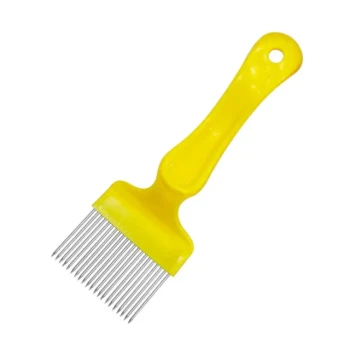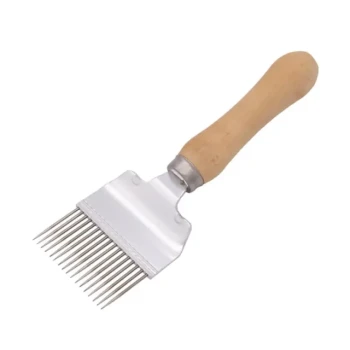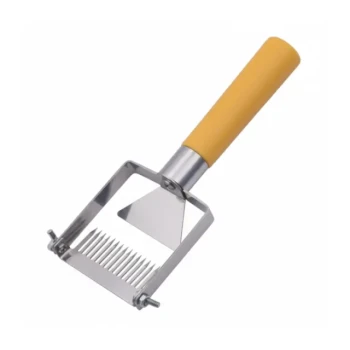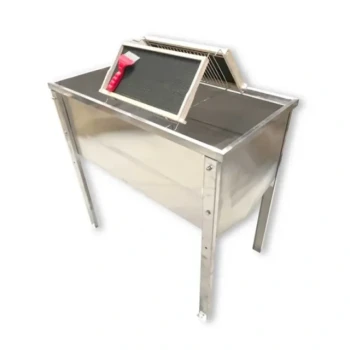To create a high-quality propolis tincture, you must dissolve clean, raw propolis in a high-proof, food-grade alcohol. The standard process involves combining one part propolis with nine parts alcohol by weight, letting it steep for one to two weeks in a dark place with daily shaking, and then carefully filtering out the undissolved solids.
The effectiveness of a propolis tincture hinges on using the correct solvent—typically high-proof, food-grade alcohol—to extract the beneficial resinous compounds. The process is a simple maceration, but success depends entirely on the quality of your ingredients and attention to detail during extraction.
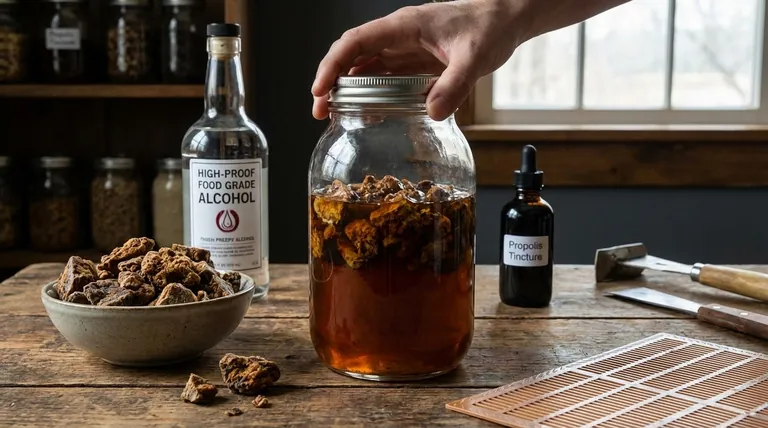
The Core Components of Tincturing
The quality of your final tincture is determined before you even combine the ingredients. Selecting the right materials is the most critical step.
Choosing Your Propolis
The process starts with clean, raw propolis. Ensure your source material is free of contaminants like bee parts, splinters of wood, or flecks of paint from the hive components.
The cleaner your starting material, the purer your final product will be.
Selecting the Right Solvent
This is the most crucial decision you will make. The solvent, or menstruum, is the liquid used to pull the desired compounds out of the propolis.
Propolis is primarily resinous, meaning its key components dissolve well in alcohol but poorly in water. For this reason, high-proof alcohol is the ideal solvent.
Look for a food-grade ethyl alcohol of at least 130 proof (65% alcohol by volume). A 70% concentration is also an excellent target. While lower-proof alcohols can be used, they are less effective at dissolving the resins.
Under no circumstances should you ever use denatured or rubbing alcohol (isopropyl alcohol). These are toxic and not safe for consumption.
Determining the Correct Ratio
A common and reliable starting point is a 1:9 ratio by weight. This means for every 1 part of propolis, you will use 9 parts of alcohol.
For example, you would combine 50 grams of propolis with 450 grams of alcohol.
More precise formulations also exist, such as using 100g of propolis per 276 ml of 70% alcohol. For beginners, the simple weight ratio is the most straightforward.
The Extraction Process, Step-by-Step
Once you have your materials, the process of maceration (soaking) is simple and requires patience more than skill.
Preparation and Maceration
Combine your measured propolis and alcohol in a glass jar with a tight-fitting lid.
Store the jar in a cool, dark place, such as a cupboard. Exposure to direct sunlight can degrade the beneficial compounds over time.
Agitation and Time
For the next one to two weeks, shake the jar vigorously once per day. This agitation is critical for ensuring the alcohol comes into contact with all the propolis, maximizing the extraction.
Some methods suggest stirring every few days, but daily shaking provides a more thorough and efficient extraction.
Straining and Storage
After the steeping period, you must filter the liquid to remove the undissolved propolis and other solids.
Pour the mixture through a fine-mesh strainer, cheesecloth, or a standard coffee filter. Be aware that propolis is incredibly sticky and will stain fabrics.
Store the finished tincture in a dark glass bottle, preferably with a dropper. Kept away from heat and light, an alcohol-based tincture is shelf-stable for many years.
Understanding the Trade-offs and Alternatives
While alcohol is the standard, it is not the only option. Understanding the alternatives helps you choose the right method for your needs.
Alcohol Tinctures: Potency vs. Palatability
Alcohol is the superior solvent for extracting the full spectrum of compounds from propolis, resulting in a potent and long-lasting tincture.
The primary trade-off is its strong, sharp taste and the fact that some individuals must avoid alcohol for health or personal reasons.
Oil Infusions: A Gentler Alternative
For an alcohol-free option, you can infuse propolis into an oil like olive oil. This is typically done by combining 1 part propolis with 9 parts oil.
Gently heat the mixture in a double boiler, keeping the temperature below 120°F (49°C) for about 10 minutes, then strain. An oil infusion will be less potent and have a much shorter shelf-life than an alcohol tincture.
Safety and Allergies
Propolis can cause allergic reactions in some individuals, particularly those with allergies to bees or bee products. Always test a very small amount before using it more broadly.
Making the Right Choice for Your Goal
Your intended use should guide your preparation method.
- If your primary focus is maximum potency and long-term stability: Use a food-grade alcohol of at least 130 proof (65%) for your extraction.
- If your primary focus is an alcohol-free preparation: Create an oil infusion using a gentle heating method, but be aware it will be less potent and must be used more quickly.
- If you are just starting out: Follow the standard 1:9 weight ratio with a high-proof grain alcohol for a reliable and effective result.
By understanding these core principles, you can confidently create a safe and effective propolis preparation tailored to your specific needs.
Summary Table:
| Key Consideration | Essential Detail |
|---|---|
| Propolis Quality | Must be clean and free of contaminants like bee parts or wood. |
| Solvent (Menstruum) | High-proof (≥130 proof/65%), food-grade ethyl alcohol is ideal. |
| Standard Ratio | 1 part propolis to 9 parts alcohol by weight. |
| Extraction Time | Steep for 1-2 weeks in a dark place with daily shaking. |
| Primary Trade-off | Alcohol offers maximum potency; oil infusions are alcohol-free but less potent and stable. |
Ready to Scale Your Beekeeping Operations?
Creating high-quality products like propolis tinctures starts with reliable equipment and supplies. HONESTBEE supplies commercial apiaries and beekeeping equipment distributors with the wholesale-focused tools needed for success. From hive tools to protective gear and extraction equipment, we provide the foundation for your productivity.
Contact our team today to discuss your wholesale needs and discover how HONESTBEE can support your business growth.
Visual Guide

Related Products
- 8 Frame and 10 Frame Propolis Trap Collector Screen for Propolis Collection
- Professional Wide Head Honey Uncapping Fork for Beekeeping
- Extra-Wide All-Stainless Steel Honey Uncapping Fork with T-Handle
- Professional Durable Plastic Handle Honey Uncapping Fork
- Wide Adjustable Stainless Steel Honey Uncapping Fork with Scraper
People Also Ask
- What are the differences between bottom-mounted and front-mounted pollen traps? Choose the Right Tool for Your Harvest.
- Can any hive have a propolis trap? Only if your colony is strong enough.
- Do beekeepers have to use a propolis trap? A Guide to Harvesting Bee Glue Efficiently
- How should a hive tool be used for hive inspection? Master the Essential Beekeeper's Multi-Tool
- How do beekeepers ensure sustainable harvesting of propolis? Prioritize Hive Health for Long-Term Yield






